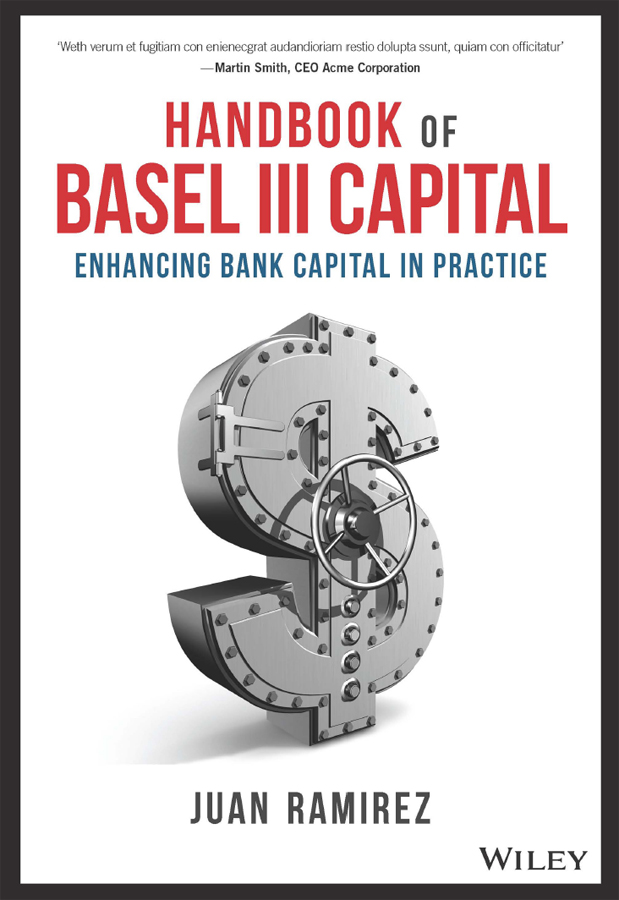Ramirez Juan - Enhancing Bank Capital in Practice
Here you can read online Ramirez Juan - Enhancing Bank Capital in Practice full text of the book (entire story) in english for free. Download pdf and epub, get meaning, cover and reviews about this ebook. year: 2017, genre: Romance novel. Description of the work, (preface) as well as reviews are available. Best literature library LitArk.com created for fans of good reading and offers a wide selection of genres:
Romance novel
Science fiction
Adventure
Detective
Science
History
Home and family
Prose
Art
Politics
Computer
Non-fiction
Religion
Business
Children
Humor
Choose a favorite category and find really read worthwhile books. Enjoy immersion in the world of imagination, feel the emotions of the characters or learn something new for yourself, make an fascinating discovery.

- Book:Enhancing Bank Capital in Practice
- Author:
- Genre:
- Year:2017
- Rating:3 / 5
- Favourites:Add to favourites
- Your mark:
- 60
- 1
- 2
- 3
- 4
- 5
Enhancing Bank Capital in Practice: summary, description and annotation
We offer to read an annotation, description, summary or preface (depends on what the author of the book "Enhancing Bank Capital in Practice" wrote himself). If you haven't found the necessary information about the book — write in the comments, we will try to find it.
Enhancing Bank Capital in Practice — read online for free the complete book (whole text) full work
Below is the text of the book, divided by pages. System saving the place of the last page read, allows you to conveniently read the book "Enhancing Bank Capital in Practice" online for free, without having to search again every time where you left off. Put a bookmark, and you can go to the page where you finished reading at any time.
Font size:
Interval:
Bookmark:

- Chapter 2: Minimum Capital Requirements
- Chapter 3: Common Equity 1 (CET1) Capital
- Chapter 4: Additional Tier 1 (AT1) Capital
- Chapter 5: Tier 2 Capital
- Chapter 6: Contingent Convertibles (CoCos)
- Chapter 7: Additional Valuation Adjustments (AVAs)
- Chapter 8: Accounting vs. Regulatory Consolidation
- Chapter 9: Treatment of Minority Interests in Consolidated Regulatory Capital
- Chapter 10: Investments in Capital Instruments of Financial Institutions
- Chapter 12: Equity Investments in Nonfinancial Entities
- Chapter 13: Deferred Tax Assets (DTAs)
- Chapter 14: Asset Protection Schemes and Bad Banks
- Chapter 15: Approaching Capital Enhancement Initiatives
- Chapter 1: Overview of Basel III
- Chapter 2: Minimum Capital Requirements
- Chapter 3: Common Equity 1 (CET1) Capital
- Chapter 4: Additional Tier 1 (AT1) Capital
- Chapter 5: Tier 2 Capital
- Chapter 6: Contingent Convertibles (CoCos)
- Chapter 7: Additional Valuation Adjustments (AVAs)
- Chapter 8: Accounting vs. Regulatory Consolidation
- Chapter 9: Treatment of Minority Interests in Consolidated Regulatory Capital
- Chapter 10: Investments in Capital Instruments of Financial Institutions
- Chapter 11: Investments in Capital Instruments of Insurance Entities
- Chapter 12: Equity Investments in Nonfinancial Entities
- Chapter 13: Deferred Tax Assets (DTAs)
- Chapter 14: Asset Protection Schemes and Bad Banks
- Chapter 15: Approaching Capital Enhancement Initiatives
This edition first published 2017
2017 Juan Ramirez
Registered office
John Wiley & Sons Ltd, The Atrium, Southern Gate, Chichester, West Sussex, PO19 8SQ, United Kingdom
For details of our global editorial offices, for customer services and for information about how to apply for permission to reuse the copyright material in this book please see our website at www.wiley.com.
All rights reserved. No part of this publication may be reproduced, stored in a retrieval system, or transmitted, in any form or by any means, electronic, mechanical, photocopying, recording or otherwise, except as permitted by the UK Copyright, Designs and Patents Act 1988, without the prior permission of the publisher.
Wiley publishes in a variety of print and electronic formats and by print-on-demand. Some material included with standard print versions of this book may not be included in e-books or in print-on-demand. If this book refers to media such as a CD or DVD that is not included in the version you purchased, you may download this material at http://booksupport.wiley.com. For more information about Wiley products, visit www.wiley.com.
Designations used by companies to distinguish their products are often claimed as trademarks. All brand names and product names used in this book are trade names, service marks, trademarks or registered trademarks of their respective owners. The publisher is not associated with any product or vendor mentioned in this book.
Limit of Liability/Disclaimer of Warranty: While the publisher and author have used their best efforts in preparing this book, they make no representations or warranties with respect to the accuracy or completeness of the contents of this book and specifically disclaim any implied warranties of merchantability or fitness for a particular purpose. It is sold on the understanding that the publisher is not engaged in rendering professional services and neither the publisher nor the author shall be liable for damages arising herefrom. If professional advice or other expert assistance is required, the services of a competent professional should be sought.
Library of Congress Cataloging-in-Publication Data is available
ISBN 9781119330820 (hardcover) ISBN 9781119330806 (ePDF)
ISBN 9781119330899 (ePub)
Cover Design: Wiley
Cover Image: Vasiliy Yakobchuk/iStockphoto
To my wife Marta and our children Borja, Martuca and David
Often banks feel Basel III regulations are excessively conservative and act as a deterrent to investors looking for attractive returns. However, Basel III is an opportunity for banks to improve their asset quality and riskreturn profiles. It encourages a strategic approach to decisions about businesses and assets, allocating precious capital toward opportunities that fit the bank's actual risk and return profiles, and exerting pressure to shed unattractive positions.
This book tries to fill a gap in the financial literature on regulatory bank capital. I found a substantial number of excellent books often written by developers of quantitative models on the estimation of credit risk parameters (i.e., exposures, probabilities of default and so on). There also several good books providing a general overview of Basel III, which are useful to grasp an introductory knowledge of the regulation, but that might be too elementary for regulatory capital professionals.
This book has two objectives: (i) to provide readers with a deep understanding of the principles underpinning the capital dimension of Basel III (i.e., the numerator of the capital ratio calculation) and (ii) to be exposed to reallife cases of initiatives to enhance capital. The first objective is a notably challenging one due to the large number of complex rules and because it requires a thorough understanding of the accounting treatment of the items affecting regulatory capital. To meet the second objective, a large number of real case studies have been included.
This book is aimed primarily at capital practitioners at banks, bank equity analysts, institutional investors and banking supervisors. I believe that it is also a useful resource for structurers at investment banks developing capitalefficient transactions and for professionals at auditing, consulting and law firms helping client banks to enhance their capital positions.
Whilst the Basel III rules are intended to provide a common framework for financial institutions, its implementation may vary across the globe, as national supervisors have discretion about the domestic implementation of the Basel III rules. This book is based on the European Union version of Basel III, which is referred to as CRD IV. Whilst some particular changes to the general Basel III framework are introduced by the CRD, most of its contents are likely to be common to the regulation of other jurisdictions.
The interpretations described in this book are those of the author alone and do not reflect the positions of the entities which the author is or has been related to.
Juan Ramirez currently works for Deloitte in London, assessing the accounting treatment, risk management and regulatory capital impact of complex transactions.
Prior to joining Deloitte, Juan worked for 20 years in investment banking in sales and trading at JP Morgan, Lehman Brothers, Barclays Capital, Santander and BNP Paribas. He has been involved with interest rate, equity, FX and credit derivatives. Juan holds an MBA from University of Chicago and a BSc in electrical engineering from ICAI.
Juan is the author of the books Accounting for Derivatives and Handbook of Corporate Equity Derivatives and Equity Capital Markets, both published by Wiley.
Overview of Basel III
Bank executives are in a difficult position. On the one hand their shareholders require an attractive return on their investment. On the other hand, banking supervisors require these entities to hold a substantial amount of expensive capital. As a result, banks need capitalefficient business models to prosper.
Next pageFont size:
Interval:
Bookmark:
Similar books «Enhancing Bank Capital in Practice»
Look at similar books to Enhancing Bank Capital in Practice. We have selected literature similar in name and meaning in the hope of providing readers with more options to find new, interesting, not yet read works.
Discussion, reviews of the book Enhancing Bank Capital in Practice and just readers' own opinions. Leave your comments, write what you think about the work, its meaning or the main characters. Specify what exactly you liked and what you didn't like, and why you think so.






